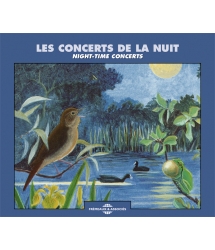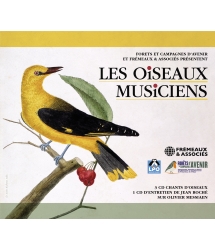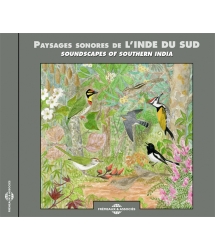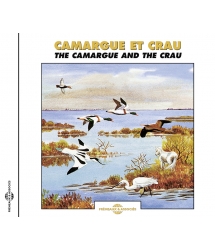- Notre Catalogue
- Philosophie
- Philosophes du XXème siècle et d'aujourd'hui
- Histoire de la philosophie (PUF)
- Contre-Histoire et Brève encyclopédie par Michel Onfray
- L'œuvre philosophique expliquée par Luc Ferry
- La pensée antique
- Les penseurs d'hier vus par les philosophes d'aujourd'hui
- Textes philosophiques historiques interprétés par de grands comédiens
- Histoire
- Livres
- Sciences Humaines
- Paroles historiques
- Livres audio & Littérature
- Notre Catalogue
- Jazz
- Blues - R'n'B - Soul - Gospel
- Rock - Country - Cajun
- Chanson française
- Musiques du monde
- Afrique
- France
- Québec / Canada
- Hawaï
- Antilles
- Caraïbes
- Cuba & Afro-cubain
- Mexique
- Amérique du Sud
- Tango
- Brésil
- Tzigane / Gypsy
- Fado / Portugal
- Flamenco / Espagne
- Yiddish / Israël
- Chine
- Tibet / Népal
- Asie
- Océan indien / Madagascar
- Japon
- Indonésie
- Océanie
- Inde
- Bangladesh
- URSS / Chants communistes
- Musiques du monde / Divers
- Musique classique
- Compositeurs - Musiques de film - B.O.
- Sons de la nature
- Notre Catalogue
- Jeunesse
- Philosophie
- Nouveautés
- Comment commander ?
- Recevoir le catalogue
- Manifeste
- Dictionnaire











- Notre Catalogue
- Philosophie
- Philosophes du XXème siècle et d'aujourd'hui
- Histoire de la philosophie (PUF)
- Contre-Histoire et Brève encyclopédie par Michel Onfray
- L'œuvre philosophique expliquée par Luc Ferry
- La pensée antique
- Les penseurs d'hier vus par les philosophes d'aujourd'hui
- Textes philosophiques historiques interprétés par de grands comédiens
- Histoire
- Livres
- Sciences Humaines
- Paroles historiques
- Livres audio & Littérature
- Notre Catalogue
- Jazz
- Blues - R'n'B - Soul - Gospel
- Rock - Country - Cajun
- Chanson française
- Musiques du monde
- Afrique
- France
- Québec / Canada
- Hawaï
- Antilles
- Caraïbes
- Cuba & Afro-cubain
- Mexique
- Amérique du Sud
- Tango
- Brésil
- Tzigane / Gypsy
- Fado / Portugal
- Flamenco / Espagne
- Yiddish / Israël
- Chine
- Tibet / Népal
- Asie
- Océan indien / Madagascar
- Japon
- Indonésie
- Océanie
- Inde
- Bangladesh
- URSS / Chants communistes
- Musiques du monde / Divers
- Musique classique
- Compositeurs - Musiques de film - B.O.
- Sons de la nature
- Notre Catalogue
- Jeunesse
- Philosophie
- Nouveautés
- Comment commander ?
- Recevoir le catalogue
- Manifeste
- Dictionnaire
FOREST MONKEYS
Ref.: FA657
Direction Artistique : CATHERINE BOUCHAIN & JEAN ROCHE
Label : Frémeaux & Associés
Durée totale de l'œuvre : 57 minutes
Nbre. CD : 1
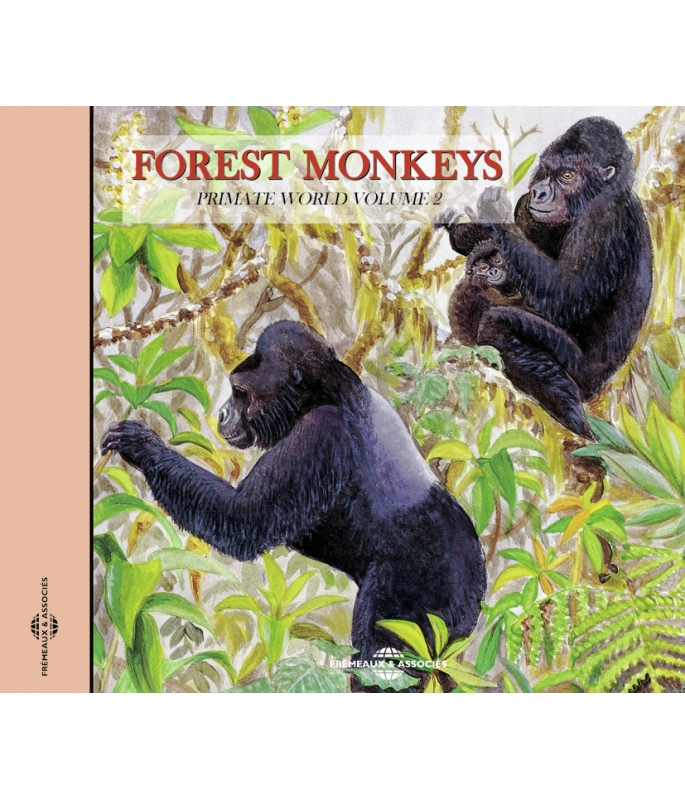
FOREST MONKEYS
Monkeys communicate using their most developed senses: mainly sight and hearing, secondarily smell and touch. Visibility is reduced in tropical and equatorial forests where monkeys use sound, the only way of communicating over large distances.
The CD includes more than an hours recordings made whilst tracking monkeys in the forests of Gabon, Cameroon and Zaire, in difficult conditions, often without the animals aware of the recorder’s presence.
Patrick Frémeaux
ENGLISH BOOKLET ONLY - VOIR FA657 "Le Monde des singes vol. 2 pour la version française
Guenons (Crowned Guenon, Wolf’s Guenon, De Brazza’s Guenon, Moustached Guenon, Greater white-nosed Guenon, Preuss’s Monkey, sun-tailed Guenon, Allen’s Swamp Monkey)
Mangabeys (White-cheeked Mangabey, Agile Mangabey)
Colobinae (Black Colobus)
Howler Monkeys (Red Howler, Black Howler)
Baboons (Mandrill)
Apes (Western Lowland Gorilla, Mountain Gorilla)
Hylobatidae (Siamang, White-handed Gibbon)
Master owner FA 657 correspond au "Monde des singes vol 2" : Frémeaux & Associés The Canadian Frémeaux Heritage / The American Heritage by Frémeaux with Catherine Bouchain & jean Pierre Gautier (Tél 00 33 1 43 74 90 24 – Fax : 00 33 1 43 65 24 22 – info@fremeaux.com) - Stéreo and digital recording of the natural landscape sound. Natural sound sceneries of écosystems, Voices of the Wild Life. The Canadian Frémeaux Heritage & The American Heritage by Frémeaux are exclusive trade mark of Groupe Frémeaux Colombini for North America distributed by SRI.

RECORDINGS FROM THE DEEP

MOUNT SAINT-HILAIRE - FORILLON NATIONAL PARK - SOREL...

A SELECTION OF COMMON BIRDS SONGS - 62 SPECIES

A SCIENTIFIC INTERPRETATION




-
PisteTitreArtiste principalAuteurDuréeEnregistré en
-
1The Crowned Guenon00:00:561995
-
2The Crowned Guenon00:00:401995
-
3'The Wolf''s Guenon'00:02:221995
-
4'The Wolf''s Guenon'00:01:461995
-
5The De Brazza Monkey00:01:001995
-
6The De Brazza Monkey00:00:591995
-
7The De Brazza Monkey00:00:511995
-
8The Moustached and The Greater White-Nosed Monkey00:01:291995
-
9The Moustached and The Greater White-Nosed Monkey00:00:411995
-
10The Moustached and The Greater White-Nosed Monkey00:01:121995
-
11The Moustached and The Greater White-Nosed Monkey00:01:101995
-
12'Preuss''s Monkey'00:00:441995
-
13'Preuss''s Monkey'00:00:401995
-
14'Preuss''s Monkey'00:00:451995
-
15The Sun-Tared Guenon00:00:581995
-
16The Sun-Tared Guenon00:00:381995
-
17'Allen''s Swamp Monkey'00:01:301995
-
18'Allen''s Swamp Monkey'00:02:211995
-
19'Allen''s Swamp Monkey'00:00:441995
-
20The Grey-Cheeked Mangabey00:00:551995
-
21The Grey-Cheeked Mangabey00:00:341995
-
22The Agile Mangabey00:00:341995
-
23The Agile Mangabey00:00:452007
-
24The Agile Mangabey00:00:441995
-
25The Agile Mangabey00:01:381995
-
26The Agile Mangabey00:03:321995
-
27The Black Colobus00:02:381995
-
28The Red Howler00:03:101995
-
29The Red Howler00:02:161995
-
30The Mandrill00:01:151995
-
31The Mandrill00:00:581995
-
32The Mandrill00:01:491995
-
33The Lowland Gorilla00:00:591995
-
34The Lowland Gorilla00:00:391995
-
35The Lowland Gorilla00:00:281995
-
36The Lowland Gorilla00:01:301995
-
37The Lowland Gorilla00:00:151995
-
38The Lowland Gorilla00:00:501995
-
39The Lowland Gorilla00:00:471995
-
40The Lowland Gorilla00:00:241995
-
41The Mountain Gorilla00:01:031995
-
42The Mountain Gorilla00:01:111995
-
43The Siamang00:02:271995
-
44The White-Handed Gibbon00:04:411995
Forest Monkeys
Forest Monkeys
Primate World Volume 2
Primate World: Forest monkeys
Monkeys communicate with their most developped senses; first of all sight and hearing, then smell, and touch. In the tropical and equatorial forests, visibility often drops to a few meters, acoustical communication becomes the most important among forest monkeys, and the only way to communicate at long-distance range. Whatever the species social structure may be, (family, multi-male group, harem), group territory and identity are supported by powerful vocalizations called loud calls, that carry far away and have an original acoustic structure. In most species, only adult males, who possess vocal annexes larger than the females’, emit such calls. These vocal annexes are sorts of sacs issued from the larynx. When inflated with air, they act as resonators, making the calls louder. Loud calls permit both rallying of group members around one or several emmittors and spacing of different groups. They have also a vital role in the defense against predators: eagles, leopards, and some snakes. On the other hand, loud calls characterize each species and play a part in their reproductive isolation. Jean-Pierre Gautier, who is a C.N.R.S. researcher, has been studying and recording african Cercopitheques and Mangabeys for more than twenty years, in the wild as well as in captivity in the Biological Research Station of Paimpont, France. He compared calls’ features in different Cercopithecine species and their evolution during ontogenesis, as he looked for their social functions: alarm, aggression, distress, contact, etc… Because of genetical reasons, monkeys can only utter calls of their own species. Surveys in different Cercopitheques repertoires made phyllogenetic affinities exhaustive; and these agree with other research approaches: behavioural, morphological, genetical. On the other hand, he realized that close subspecies calls were very similar, though their coloured patterns were quite different. In Cercopitheques, as in Mangabeys and Colobus, the variability in fur and mask patterns is wider than in calls. The recordings of this CD occured during the tracking of monkeys, in bush aeras of Gabon, Cameroon and Zaïre; the conditions were bad and often animals hadn’t detected the observer. Catherine Bouchain recorded Gorillas in oder to establish their vocal repertoire and to compare it to the Mountain Gorilla’s. In the field Station called: “Station d’Études des Gorilles et des Chimpanzés” created by Carolin Tutin and Michel Fernandez, gorillas were quite unused to observers, and difficult to track and observe. This survey was completed with observations of captive animals, but all the sounds in this CD were recorded in the wild.
A. GUENONS
African monkeys live in social groups that are very different depending on the species: family group of the De Brazza Monkey includes the couple and one or two juveniles, whereas big Mandrill’s groups are made up of 300 members or more. Most of the arboreal species form fifteen to twenty members harems* (cf. Lexicon at the end of the booklet). But one often meets large mixed-species troops made of two, three, four, even five different guenons. Jean-Pierre Gautier and Annie Gautier-Hion showed that these polyspecific associations were flexible, unconstant; the participants join forces to defend against Crown-hawked eagles and Leopards. They also have improved the run of food ressources in their living territory, mainly fruit, and share the same diurnal activities. When loud calls are uttered, mostly at dawn and at dusk, in a same mixed-species troop the male leaders* of each species answer each other and you will hear real phonoresponses. Among certain Guenons, males emit “Booms” with their vocal sac, which are combined with other calls within stereotyped vocal sequences*.
• The Crowned Guenon (Cercopithecus pogonias grayi):
It is found in South Cameroon, in Gabon, in Congo as far the Zaïre river that it doesn’t cross. Its graceful proportions, the yellow or bright orange of its belly, the crest and the black triple head-band that decorates the adult male make it a superb animal. It mixes with other species and often becomes the leader of the association. The adult male has a well developped vocal sac which allows it to emit “Booms”.
--> Recordings:
1. The loud calls of a first male, close, stimulate a second male, far off, who will emit in turn. In the background some alarm and contact calls from females and juveniles can be heard.
- Background: song of the black tip crested Turaco, (starts before the first male barks), pure and singsong notes of the brown Illadopsis.
- GABON, M’Passa Plateau. 24/07/72, 6 h 19. (J-P Gautier). Duration: 0’56”
2. A Mona troop is feeding in a tree. Fruit drops down and guenons are moving through the branches. Alerted by the observer’s presence, they start to emit alarms: “Pityak!… pityak!…” that present the same bisyllabic pattern as the adult male’s loud calls. But they are quite higher-pitched and indicate smaller animals, adult females or juveniles.
- Background: insects, birds: six note rising sentences of the Congo Flycatcher.
- GABON, M’Passa Plateau. 24/07/72, about 6 h 00. (J-P Gautier). Duration: 0’40”
• The Wolf’s Guenon (Cercopithecus wolfi wolfi):
It belongs to the same superspecies as the Crowned Guenon, but lives on the left side of the Zaïre river. The silhouettes of the two species are quite similar but Wolf’s Guenon has a double black head-band instead of triple, and its ear tufts, belly and lower limbs are bright orange. Its vocal repertoire is also quite similar to the Crowned Guenon’s and it forms mixed-species troops with Cercopitheques, Mangabeys and Colobus from the Zaïre river’s eastern side.
--> Recordings:
3. Loud call sequence from a male leader. The main pattern, two “Booms” + Barks, is the same as the Crowned Guenon’s, but the barks are higher-piched. Around the utterer the whole band is busy: leaping in branches, “Omee” social contact* calls from females and juveniles, and few low-piched aggressive alarm calls.
- Background: insects.
- ZAÏRE, Salonga National Park, Botsima. 22/07/91, between 16 h 45 and 17 h 00. (J-P Gautier). Duration: 2’22”
4. “Omee” contact calls and bisyllabic alarm calls, from a troop feeding uptree: branches are broken and fruit dropped on the ground. The adult male appears between 1’20” and 1’45” with three low-pitched alarm calls.
- Background: powerful insects, birds: cooing calls of the great blue Turaco.
- ZAÏRE, Salonga National Park, Botsima. 02/07/91, between 17 h 30 and 18 h 00. (J-P Gautier). Duration: 1’46”
• The De Brazza Monkey (Cercopithecus neglectus):
It’s the only monogamous african species whose geographic range extends from northeastern Gabon into Kenya and from southern Kenya to the central basin of Zaïre. It’s a semi-terrestrial monkey which lives in swamp forests close to the rivers. Its mask has a white beard, a front diadem followed by a band of black hair at the top of the head which makes it look like an old, heavily-built sage. It is calm and quiet, and in case of danger it can stay motionless for several hours. Like the Crowned Guenon it can utter “Booms” but the inflating of its vocal sac is sound-giving too, and the following barks are monosyllabic and less numerous.
--> Recordings:
5. First example of a loud call sequence.
- Background: insects, birds: three note sentences of the red chested Cuckoo, regular notes of the yellow throated tinker Bird, Hornbills’ sounding flights and calls.
- ZAÏRE, Salonga National Park, Botsima. 02/09/91, between 16 h and 16 h 20. (J-P Gautier). Duration: 1’00”
6. Second example of loud call sequence: the rest of the family keeps quiet, as in the first case.
- Background: noise-making insects.
- GABON, M’Boundou. 02/09/72. (J-P Gautier). Duration: 0’59”
7. Alarm calls of an adult and a juvenile.
The adult’s powerfull calls join immediately the trisyllabic and weak alarms of the juvenile.
- Background: insects, birds, triple note ascending sentences of the black Cuckoo.
- GABON, M’Boundou. 02/09/72. (J-P Gautier). Duration: 0’51”
• The Moustached (Cercopithecus cephus) and the Greater White-nosed Monkey (Cercopithecus nictitans nictitans):
These two arboreal species often mix together, the “Moustak” at a low level of the forest and the Greater White-nosed Monkey high in the canopy*. They inhabit primary forest but the Moustak has gotten used to secondary growth aeras. The Greater White-nosed’s distribution extends from southeastern Nigeria to Cameroon and from the Centrafrican Republic to the Zaïre river that makes up its southern limit. As for the Moustached, its repartition is bordered in the North and in the South with the lower Zaïre. It’s found in Congo, Gabon and in the South of Cameroon. The Greater White-nosed Monkey is quite a heavy guenon, entirely dark with only a white nose. It often shakes its head, moving this only bright spot which becomes a signal for conspecifics. That’s the reason for its name, or the name: the “Shaker”. The Moustached Monkey is a very lively little guenon. Its blue muzzle is adorned with a white moustache, and that’s where its name comes from. The Greater-White nosed Monkey is a noise maker. Thanks to large vocal sacs, males can utter powerful barks. To the opposite, the Moustached is relatively discreter, the same calls are less frequent and mostly less intense, because of its small-sized vocal sacs. Nevertheless, in case of danger coming from the ground, the Moutached’s high-piched alarm calls advise the more placid Greater-White nosed. This makes gabonese hunters say that, for its security: “the little white Muzzle must consult the little blue Muzzle”.
--> Recordings:
8. A Greater White-nosed Monkey’s loud call sequence “Inya” (rallying).
- Background: insects, birds: blue Cuckoo’s shrike dropped notes, high-pitched ruffling sounds make by the fluttering wings of Grauer’s green Bird.
- GABON, Forêt des Abeilles, Makandé.19/02/94, 6 h 00 to 6 h 15. (J-P Gautier). Duration: 1’29”
9. Greater White-nosed Monkey’s loud call sequence, with “Inya” and “Oh” alternating series, (gathering and spacing). A Crowned Guenon utters its barks in the background.
- Background: insects, birds: blue-headed Dove’s fluid accelerated notes.
- Same reference as above. 7 h 00 to 7 h 10. (J-P Gautier). Duration: 0’41”
10. Moustached and Greater White-nosed Monkeys’ loud call series: At dusk a mixed troop gathers in a sleeping-site. Moustached and Greater White-nosed leaders are going to exchange their loud calls, setting a rythm like a counter calling.
- Background: insects, birds: blue throated Sunbird’s high-pitched quickly descending trill.
- GABON, Forêt des Abeilles, Maki. 12/03/85. 6 h 00 to 6 h 20. (J-P Gautier). Duration: 1’12”
11. Another loud call exchange from a Greater White-nosed and a Moustached: In the end of the afternoon, a Greater White-nosed Monkey troop comes to take its Moustached troop to the sleeping site. The alarms from subadults and females of both species sound like birds calling and are indistinguishable from one another. They will start the emission of the Moustached leader loud calls, soon the Greater White-nosed will utter in turn.
- Background: insects.
- GABON, Bengoué. 12/06/69. 17 h 25 to 17 h 35. (J-P Gautier). Duration: 1’12”
The L’Hoesti Superspecies: it is represented by three species whose distribution areas are separate. Preuss’s Monkey exists only in Cameroon and on Bioko island. L’Hoest’s Monkey lives in eastern Zaïre, in southern Uganda and in Rwanda. The Sun-tailed Monkey is found only in Gabon in the Forêt des Abeilles. The three are semi-terrestrial: they move on the ground, in case of danger they flee on the ground, and climb uptree only in order to feed and to sleep. They live in about fifteen member troops.
• Preuss’s Monkey (C. (l’hoesti) preussi):
Thanks to a well developped vocal sac, the adult male of this species utters very loud calls made up of two successive vocalizations: Stereotyped sequence of loud calls: “Whoop!................ huuuuuurrr................”
--> Recordings:
12. Four “Whoop!…huuuuuurrr…” emitted by the leaders of some neighbouring troops, which answer each other.
- Background: insects, birds: small Turaco’s rough alarms.
- CAMEROON, Mount Cameroon Reserve, Kotto. 23/02/85, 8 h 29. (J-P Gautier). Duration: 0’44”
13. Little coughed alarm calls from the adult male to the observer, as the troop wakes, along with branch noises. Unlike former monkeys, the acoustic structure of Preuss’s Monkey’s alarm calls differs completely from the structure of its loud calls.
- Background: insects, birds: blackcap Illadopsis’ high-piched whistle, yellow spotted Barbet’s soft roulade.
- CAMEROON, Mount Cameroon Reserve, Kotto. 17/02/85, between 7 h 06 and 7 h 30. (J-P Gautier). Duration: 0’40”
14. Subadult male’s high-pitched alarm calls + one low-pitched alarm from the adult male.
- Background: insects, birds: yellow billed Barbet’s regular notes, a small Turaco starts to call during the recording.
- Cameroon, Mount Cameroon Reserve, Kotto. 24/02/85, between 8 h 52 and 9 h 00. (J-P Gautier). Duration: 0’45”
• The Sun-tailed Guenon (Cercopithecus l’hoesti solatus):
In 1984, a young primatologist, Mike Harrison finds in Gabon a monkey whose morphology and color patterns are unknown to him. He identifies it as a l’hoesti superspecies member, and that will be confirmed by further morphological and genetical analysis. Named Sun-tailed Monkey because of its orange tipped tail, it has an extremely reduced geographic range (less than 10.000 km2 in the “Forêt des Abeilles”). Moreover, it knows exactly how to hide. For the local hunters, who call him the M’Baya, it is the cleverest monkey. Unlike Preuss’s Guenon, it doesn’t utter any specific loud calls, only nasal alarm barks.
--> Recordings:
15. An adult male’s nasal alarm barks.
- Background: insects, birds: various calls of grey Parrots.
- GABON, Forêt des Abeilles, Maki. 18/02/86, 9 h 06. (J-P Gautier). Duration: 0’58”
16. In a sleeping site, animals awoken: adult male’s juveniles’ alarm calls towards the observer: one can hear first juveniles and females clang liked high-piched alarms, that sound like birds tchirping, and then the adult male, lower-pitched. Gradually, the male stops, juveniles and females carry on.
- Background: insects.
- GABON, Forêt des Abeilles, Makandé. 03/05/93, from 6 h until 6 h 30. (J-P Gautier). Duration: 1’45”
• Allen’s Swamp Monkey (Allenopithecus nigroviridis):
It lives in numerous troops, at least fourty individuals, in the impenetrable swamp forest areas of the Congo basin. It doesn’t have any bright coloured mask like other Cercopitheques of whom he would be the ancestor. During the day, monkeys move on the ground that hangs between the roots of the trees. In the evening, when the group gathers uptree beside a river for the night, what an excitment! Calls, whistles, loud calls from the adult males, leaps in the branches. In this species, the vocal sac is well developped. Loud calls are made of low-pitched hiccup series.
--> Recordings:
17. Rapid series of metallic sounding alarm calls from females and juveniles towards the observer.
- Background: insects.
- ZAÏRE, Ekele. June 1984, 16 h 00. (J-P Gautier). Duration: 0’38”
18. Two series of slower high-pitched chirp alarm calls, resembling birds’, then loud calls from the adult male.
- 1rst sequence background: insects, birds: yellow throated tinker Bird’s regular notes, red chested Cuckoo’s triple note sentences, blackcasqued Hornbill’s moans.
- 2nd sequence background: insects, birds: red chested Cuckoo, black casqued Hornbill noisy flight.
- ZAÏRE, Salonga National Park, 10/07/91, from 18 h 00 to 18 h 30. (J-P Gautier). Duration: 1’30”
19. At dusk, an Allen’s Swamp Monkey group joins it sleeping site. The forest resounds with insect noises, birds (Hagedash Ibis, parrots, etc…) and frogs. More and more excited, juveniles utter isolation calls preceded by overshrill whistles: “Seeeeek!…Ruuumm!…Ruuumm!…”, that will raise to a paroxysm. They come in the foreground with frogs. A few contact-cohesion “Bro” appear in the background, shrill clang alarms and leaps in branches. The adult male appears with a low-pitched hiccups series to get everyone’s attention.
- Background: insects, frogs, birds: Hagedash Ibis, grey Parrots.
- ZAÏRE, Salonga National Park. 10/07/91, from 18 h 00 until 18 h 30. (J-P Gautier). Duration: 2’21”
B. MANGABEYS
Mangabeys belong to the Papionines subfamily, along with Macaques and Baboons which share many morphological and behavioural caracteristics. All are forest monkeys. Some like the White-cheeked Mangabey are tree-dwelling, whereas the others are terrestrial or semi-terrestrial. It’s the case for the Agile Mangabey, so named because of its extraordinary velocity.
• The Grey-cheeked Mangabey (Cercocebus albigena):
This beautiful black guenon’s, long and glossy fur turns silver on its cheeks and shoulders that are covered as with a cape. Its head is adorned with two long horn-shaped eyebrows and an unruly tuft of hair which makes it look like a “punk”. It smartly moves through the canopy, in groups of twenty members. Most of the time only two adult males utter loud calls in the group. These loud calls caracteristic from Mangabeys are made with two vocalizations. Stereotyped loud call sequence: “Whoop!........... Gobble” Low-pitched hiccup series “Whoop!” emits the Grey-cheeked Mangabey in a way that resembles Preuss’s Monkey, followed by series of hiccups from Allen’s swamp Monkey. Most of the time two loud calls follow each other, sometimes more. With these calls, leaders from neighbouring troops exchange territorial informations. The “cawing” alarms of this species, called “lyaos” are typical of Mangabeys, too. Higher-pitched among juveniles and females, they are louder and lower-piched among adult males, and form impressive concerts.
--> Recordings:
20. Three “Whoop Gobble” series by a leader male: the recording includes two sequences.
- 1rst sequence background: insects, birds: yellow throated Nicator.
- 2nd sequence background: insects, birds: blackcap Illadopsis’ high-pitched song, bristle Bill’s nostalgic sentence.
- GABON, Forêt des Abeilles, Maki. 18/02/86, 9 h 00. (J-P Gautier). Duration: 0’44”
21. “Iyao” alarms in group mixed with Crowned Guenons.
- Background: insects, very present birds: yellow breasted Barbet’s quickly repeated notes, grey Parrots’ calls and whistles, brown Illadopsis’ hoarse notes.
- GABON, Lopé Reserve, S.E.G.C. 13/12/86, from 9 h 30 until 10 h 00. (C. Bouchain). Duration: 0’55”
• The Agile Mangabey (Cercocebus galeritus agilis):
It is found in northeastern Gabon. This area constitutes the western limit of the geographic range for this species whose kin live in Central Africa on the eastern Zaïre river side. Some are found as far as the eastern african coast. The Agile Mangabey is a semi-terrestrial monkey that lives in little social groups of about ten members with only one adult male. It settles primary swamp forests where it can easily escape from terrestrial predators that find moving difficult. Adult males utter: “Whoop!… hiccup series” and the “Aaauu” alarms in this species are very close to the White-Cheeked Mangabey’s. Among agile Mangabeys, aggressive calls and shrill distress calls are very frequent. Their social life seems quite agitated and closer to Macques’ than to arboreal Mangabeys’.
--> Recordings:
22. Two loud calls series.
- 1rst sequence background: insects.
- 2nd sequence background: insects, birds: Congo Flycatcher.
- GABON. M’Boundou. 01/09/72, (J-P Gautier) and N’Djaddié, 27/07/76. (R. Quris). Duration: 0’34”
23. “Aaauu” alarm series.
- 1rst sequence background: insects.
- 2nd sequence background: insects, birds: Congo Flycatcher.
- GABON. M’Boundou. 01/09/72, from 8 h 30 to 8 h 45. (J-P Gautier) and N’Djaddié, 27/07/76. (R. Quris). Duration: 0’37”
24. Alarm calls towards the observer from a troop recorded near a stream.
At first some “Aaauu” alarms from females and juveniles then lower-pitched and louder alarms from the adult male.
- Background: insects.
- GABON, N’Djaddié. 27/07/76. (R. Quris). Duration: 0’44”
25. During a quarrel, partners exchange shrill calls.
The adult male eventually utters four slow series of cohesion calls to restore peace.
- Background: insects.
- GABON, N’Djaddié. 24/07/76. (R. Quris). Duration: 1’38”
26. Polyspecific alarm (Greater White-nosed Monkey, Crowned Guenon and White-cheeked Mangabey). The hunter who went with Jean-Pierre Gautier cuts a few small leafy branches and shakes them violently to imitate the fluttering of an eagle that has captured a monkey, and the noise of branches that accompanies the capture. Gabonese hunters often use this stratageme to attract adult males which may come very close to the ground, where they can be shot easier. They can also imitate the Crowned eagle’s shrill whistles and the Greater White-nosed Monkey’s violent barks. Repeated several times, here these noises start a widespread alarm where White-cheeked Mangabey’s “Iyao” are in the dominant position. One can hear Greater-White nosed’s alarms too, in the background come the alarm barks of the Crowned Guenon leader. The violence of their reaction is related to the danger arriving from their worst predator.
- Background: insects.
- GABON, Bengoué. 16/06/69. (J-P Gautier). Duration: 3’32”
C. COLOBINES
Colobines are deprived of hand thumbs. They are mostly folivorous which is permitted by their large and partitioned stomachs. They also eat seeds and fruits. Most of the species live in Asia, only the Colobus genus is african.
• The Black Colobus (Colobus satanas):
It’s a very beautiful monkey, jet-black fured and cut out eared like a devil. Unlike other Colobines it feeds essentially on seeds. Black Colobuses live in harems and are approached easier than fierce Guenons. They haven’t got any vocal sac but a larynx that enables them to utter loud and deeps roarings. A gabonese legend says they are asking God for thumbs: “Why me four fingers?… Why me four fingers?…” In reality, deep and frequency modulated roarings are as much an alarm as a collective territorial call.
--> Recordings:
27. Roaring chorus in a group mixed with Crowned Guenons: A Colobus starts emitting “coughed calls”. These turn into “coughed-call + roaring” and press other Colobuses to utter in turn. The chorus will spread gradually to the whole group, with leaping in branches, and then drops. In the background, Crowned Guenons’ alarms. One can hear the Hornbill’s noisy and clumsy flight in the end.
- Background: insects, birds: Woodpeckers’ drummings, blackcasqued Hornbill’s fluttering, Hornbills’ derisive calls.
- GABON, Lopé Reserve. 24/03/1987, 11 h 00. (C. Bouchain). Duration: 2’38”
D. THE ALOUATTINAE OR HOWLING MONKEYS
Six different species dwell in South America, from northern Mexico to northern Argentina. Arboreal, Howling Monkeys use their prehensile tail as an anchor to hang in the higher level of the canopy where they live. Their multi-male groups can be made up of twenty-five individuals. Males and females have vocal sacs and sing together, males emit the lower pitched sounds.
• The Red Howler (Alouatta seniculus):
It’s the species of the Alouattinae that lives the furthest North, its geographic range overlaps from northern Colombia and Venezuela until central Bolivia and northern Brazil. It’s always a forest monkey, its habitat is variegated (mangroves, tropical or rain forests), from sea level to 3.200 meters in altitude. Loud calls have a range of 1 kilometer and are uttered most of the time during the night, between 2 h 00 and 7 h 00 in the morning, while monkeys have their rest. They stay in the canopies of their sleeping trees, the highests in the forest, at about fourty or fifty meters from the ground.
--> Recording:
28. A loud call recorded at dawn, under an Alouattinae group sleeping tree.
- Background: insects.
- French Guiana, Nouragues. 03/05/87. (R. Vercauteren-Drubbel). Duration: 3’10”
• The Black Howler (Alouatta caraya):
It’s found in eastern Bolivia, northern Argentina, Paraguay and southern Brazil. Like the Red Howler, it settles varied forested habitats. On another hand, it shows a strong sexual dimorphism: only adult males are black, females are a pale creamy grey.
--> Recording:
29. At dawn, perched in a tree in the middle of swampy areas called “pantaneira”, three monkeys utter their loud calls.
- Background: in the first ground Chaco Chachalacas, behind Kiskadees and Hyacinth macaws.
- Brazil, Pantanal. October 1991. (E. Matheu). Duration: 2’16”
E. BABOONS
The african shrubby savannahs are home to four baboon species, which settle in large multi-male groups. A fifth one, the Hamadryas baboon, whose social organization in harems is particular, lives in semi-desertic areas of the Arabic peninsula. Two species are forest dwellers: Drill and Mandrill, and have been developing adaptations to their habitat (bright colours and original vocal repertoire), remaining terrestrial as other baboons.
• The Mandrill (Mandrillus sphinx):
It can be differentiated at the first glimpse from other baboons by the bright red and blue colours of its face mask and the genitalia of the adult male. We met Mandrills in noisy and numerous troops, as much as 400 individuals when we could count them, at a river or road crossing. They progress in the forest piking food as they go. Adults walk most of the time on the ground, and subadults climb up young trees that they bend towards ground. After their passage the forest is really cleared of leaves and certain fruit. We observed that adult males walked in front and periphery of the moving group, emitting two types of calls:
- cawing barks similar to those of other baboon’s,
- unceasingly, “Hmmmmm… Hmmmmmmm”, deep and modulated.
--> Recordings:
30. Adult males vocalizations as a big group travels. In the background appear the females’ and juveniles’ shrill calls.
- Background: insects.
- Gabon, Lopé Reserve, S.E.G.C. 16/05/86, from 9 h 00 until 10 h 00. (C. Bouchain). Duration: 1’15”
31. Away from the group, two big males come across each other in the canopy.
They leap from one branch to another, shaking them vigorously, and uttering hoarse tri or quadrisyllabic barks.
- Background: insects.
- GABON, Lopé Reserve, S.E.G.C. 15/07/86, 17 h 30. (C. Bouchain). Duration: 0’58”
32. In a big moving group, one can hear the shrill “cakling laughters” and the “coughs” uttered by juvenile and females. “Laughters” probably help certain group members to keep in touch (a juvenile and its mother for example), and “coughs” to keep everyone at a right distance.
- Background: insects.
- GABON, Forêt des Abeilles, Makandé. 17/02/86. (J-P Gautier). Duration: 1’49”
F. THE PONGIDAE OR APES
Orang-utans, Chimpanzees and Gorillas are very close to Man by the genetical and biological caracteristics. They have no tail, their binocular vision is excellent and females have a nearly nine month long gestation. They live in equatorial forests, of Africa for Chimpanzees and Gorillas, of Sumatra and Borneo for Orang-utans.
• Gorilla (gorilla gorilla):
One distinguishes in fact three Gorilla subspecies: the Mountain Gorilla from the Virunga volcanoes is well known thanks to Diana Fossey’s work. The Eastern Lowland Gorilla’s geographic range borders the Mountain gorilla’s. The Western Lowland gorilla is found from southeastern Nigeria as far as southern Congo. Gorillas live in harems controled by an adult male recognizable by its silver back. Essentially terrestrial and vegetarian, they climb uptree to feed on fruit or build their nests sheltered from the rain. In 1972, Diana Fossey counted 16 different vocalizations in the Mountain Gorilla. Most of them were found in The Western Lowland Gorilla. Always according to Diana Fossey, it’s the silverbacked group leader who calls out most of the time, and who emits the most varied calls. In fact, he plays a very important role: it regulates quarrels between females, plays with juveniles, and also leads the group that he guards, most of all from other males searching for females. To communicate, Gorillas use different striking sounds, made with and or feet. The best known is chest-beating, a chest striking with and palms. It goes with different animal calls or activities, and shows their excitment.
• The lowland Gorilla (Gorilla gorilla gorilla):
It’s the smallest of the three Gorillas, frugivorous and arboreal. The main part of the recordings were made at the: “Station d’Études des Gorilles et des Chimpanzés” in the Lopé reserve, Gabon, where Carolin Tutin and Michel Fernandez’ team tracks and follows groups which are still not used to human observers.
--> Recordings:
Silverback intimidation display and group reactions in case of danger:
33. First intimidation display example: the Silverback discovers two observers and wants them to go back. The rest of the group has taken refuge in the valley where it remains completely silent. Sequence: “Threat Barks + charge + hand or foot thumping on ground”.
- Background: insects, birds: black casqued Hornbill’s moans and noise-making flight, eventually Bristle Bill’s nostalgic sentences.
- GABON, Lopé Reserve. 10/05/86, 10 h 00. (C. Bouchain). Duration: 0’59”
34. Second intimidation display example: another Silverback has discovered the observers, in an extremely bushy area (creepers brushwood). For several hours, it's going to stay completely invisible about ten meters away from them, threatening them from time to time. Sequence: “chest-beats + threat barks + “coughed calls” + fart”.
- Background: insects.
- Gabon, Lopé Reserve. 18/08/86, 13 h 30. (C. Bouchain). Duration: 0’39”
35. Group reaction during a very close contact: the observers are face to face with a group of gorillas, only a few meters from each other. The Gorillas are surprised. Sequence: Silverback intense “staccato series” + other Gorillas “shrill barks” of fright + animals flight noises.
- Background: insects.
- GABON, Lopé. 29/01/87, 9 h 50. (C. Bouchain). Duration: 0’28”
36. In two sequences, chest-beating series, then observers detected by Gorillas.
- 1rst sequence: Excited, a young Gorilla slaps its chest.
- 2nd sequence: Always some chest-beats, and foraging noises. The anxiety bark of a first Gorilla provokes the observer’s discovery by a second Gorilla, closer, who barks in turn. Animals move away in the vegetation.
- Background: insects, birds: little Greenbul’s harsh repeated calls. In the end Crowned Guenon’s alarm bark.
- Gabon, Forêt des Abeilles, Maki. 12/03/85, 16 h 50 until 17 h 20. (J-P Gautier). Duration: 1’30”
37. The Question Bark: Gorillas know that human beings are there and keep on feeding quietly. A few hours later we decide to leave them and grunt while moving away. Then the Silverback utters a trisyllabic bark named the “Question Bark” by Diana Fossey because it sounds like: “Who are you?”.
- Background: insects.
- Gabon, Lopé Reserve. 29/01/87, 9 h 50. (C. Bouchain). Duration: 0’15”
38. Blackback (young male), intimidation display: the Silverback who fed in a tree saw us. He called before vanishing with the group in the brushwood very silently. A few minutes later, we go to the tree for trail examination. We are received with repeated barks, weak, high pitched and sometimes hesitating. It’s a blackbak, who had remained behind the troop, trying to intimidate us.
- Background: insects.
- GABON, Lopé Reserve. 12/02/86, 8 h 30 until 8 h 40. (C. Bouchain). Duration: 1’03”
Quarrel inside a group:
39. Intense “coughed-grunts” and shrill exchanges of distress grunts, and tradding noises.
- Background: insects.
- GABON, Lopé Reserve. 18/08/86, 17 h 00. (C. Bouchain). Duration: 0’ 47”
40. Two following “Hoo’s series” followed by chest-beats.
- Background: insects, birds: emerald Cuckoo’s three notes sentences, the third note is higher pitched, little Greenbul’s variegated and cheerful song.
- GABON, Lopé Reserve. 31/01/87. (C. Bouchain). Duration: 0’24”
• The Mountain Gorilla (Gorilla gorilla beringei):
The Mountain Gorilla is found up to 3.800 meters, the alpine limit of the slopes of the Virunga volcanoes. Its fur is quite thicker than Lowland Gorilla’s who also has a different shaped face and shorter arms. It’s less arboreal, too. Average group size is more important: ten members as opposed to 5/6 for the Lowland Gorilla. For the creation of Volcanoes Park and Karisoke Research Center by Diana Fossey, some groups have been well used to human observer’s attendance. Nevertheless, they are still poached, and war did not spare them: with 500 individuals, Mountain Gorillas are a very endangered species.
--> Recordings made in the Volcanoe Park:
41. Different vocalizations and noise exchanges: chewing noises and contentment “vibrant calls”, then some “coughed-grunts” and two anxiety barks of the “Who are you?” type, eventually a vocalization followed by a chest-beating.
- RWANDA, Virunga National Park. July 1986. (B. Tarière). Duration: 1’03”
42. Quarrel inside a group, coughed-grunts from several animals, sometimes close to “pig grunts”, as they were called by Diana Fossey.
- RWANDA, Virunga National Park, July 1986. (B. Tarière). Duration: 1’11”
G. HYLOBATIDES
Gibbons and Siamangs are without tails. Hanging from branches by their immense arms, they move rapidly through southeastern asian primitive forests where they live. Siamangs prefer more mountaineous areas. Except for a few polygamy cases in certain Gibbon species, Hylobatides are monogamous, and their families are of about five members.
• The Siamang (Hylobates syndactylus):
Siamang’s chorus can carry about two kilometers to human ear in the forest. It lasts about fifteen minutes and occurs mostly in the morning, between 8 h 00 and 9 h 00. This vocal emission starts with a light chattering that gets more intense as the animals’ excitment grows. Then the male starts uttering “Booms”, as it inflates its vocal sac which gets coloured on the occasion, and every three minutes, the female utters a regular series of barks. At the peak of the chorus, the male utters a shrill call and the whole family leaps from branch to branch. Different Siamang families start others and the concert moves gradually through the hills.
--> Recording:
43. Morning chorus and rythmic shakings in a six members Siamang family.
- Background: birds.
- MALAISIA. Fraser’s Hill. 10/03/07. (J-C Roché). Duration: 2’27”
• The White-handed Gibbon (Hylobates lar):
Gibbons elaborate magnificent male-female duets, magnified with the use of their vocal sacs. In White-handed Gibbon, song occurs often in the same morning hours as in the Siamang. The male utters a calling sentence and the female replies with varied little calls. The male insists until the female emits a long ascending sentence that goes up to die away in the air; then he calls the female again, and so on. One couple’s territorial duet starts other duets in neighbouring couples and these very pure sounds resound throughout the whole forest. While they sing, Gibbons maintain their territory and reinforce the bonds that join partners together.
--> Recording:
44. Couple’s morning duet, the female will answer the male twice.
- Background: insects, birds.
- Malaisia, Taman Negara Park. 05/03/77. (J-C Roché). Duration: 4’41”
Lexicon
1. Bioacoustics
- Loud call: powerfull call emitted most of the time by the male leader of a social group. Certain species have a vocal sac that reinforces the signal and increases its range. Loud calls rally group members around the emittor and maintain other conspecific groups at a distance.
- Cohesion-contact call: two sorts of calls help supporting an animals’ group unity:
a) cohesion calls allow group members to locate each other.
b) contact calls are emitted by the young asking for a closer contact with their mother. Both calls may merge into one in certain species.
- Isolation call: call from a juvenile or a young animal when it’s separated from its own group or its mother. Often the isolation call is an intensified and prolonged contact call.
- Vocal repertoire: different call types given by one species.
- Vocal sac: sorts of sacs connected to the larynx. They are either ossified or soft and act as resonators. They modify vocal outputs and amplify the intensity of sounds.
- Sonagram: visual sound transcription.
- Acoustic or sound structure: variations in sound frequency and intensity during the whole time. It’s visualized on a sonagram.
- Syllabe: matches human language syllabes. Then one can speak of monosyllabic (one syllable), twosyllabic (two syllables), threesyllabic calls etc…
- Stereotyped vocal sequence: vocalizations series whose sound and temporal patterns are set. Often signals that characterize a species, as loud calls, are stereotyped. They allow the identification of the species.
2. Primatology
- Polyspecific association: animal group whose members belong to different species.
- Canopy: the highest level in the forest, it’s the height where branches spread out.
- Sexual dimorphism: morphological differences between males and females in the same species. For example in Gorillas, males are twice as heavy as females, in Black Howler males are black and females creamy grey.
- Sleeping site: place where animals gather to spend the night.
- Harem: kind of social structure. A typical harem has a male, several females and their offspring. As they approach adulthood, mature males are kept away and sometimes even chased out their original harem: they become solitary males questing for females to found their own harem.
- Reproductive isolation: species last more especially since hybridization with other species is limited. Signals (colors, postures, calls), allow partners to recognize each other as conspecific, and take a part in its reproductive isolation. Species specific loud calls play this role.
- Multi-male group: form of social group. Multi-male groups have several males, several females and their offspring.
- Leader: most often a male, it leads its group whose daily activity is rythmed by its calls. It defends the group against predators and has an access to reproductive females.
- Monogamy: in a monogamous species, males and females live by pairs. Basic social unit is the family.
- Polygamy: in a polygamous species, ony one male mates with several females. Basic social unit is the harem.
- Social structure: it deals mainly with social group structure in a species: family, harem multi-male group.
Acknowledgements
We thank all those who took a part in this work:
• Doctor Claude Chappuis identified african backgrounds birds,
• Jonathan Kingdon drawed monkey’s portraits inside the booklet,
• Jean-Pierre Richard is the author of a sonographic analysis software, he did the sonagrams,
• Eloïsa Matheu, René Quris, J-C Roché, Bruno Tarière, Régine Vercauteren-Drubbel contributed to the sound matter.
- The book “Tous les Singes du Monde” from Jean-Yves Collet, was a precious help.
Catherine BOUCHAIN - Jean-Pierre GAUTIER
© 1995 SITTELLE – 2007 FRÉMEAUX & ASSOCIÉS
CD Forest Monkeys - Primate World VOL. 2 By Catherine Bouchain & Jean-Pierre Gautier© Frémeaux & Associés. Droits audio : Frémeaux & Associés - La Librairie Sonore (Producteur initial : Sittelle, Pithys, Collection Allain Bougrain Dubourg ou Ceba) / Ecouter les chants d'oiseaux sur CD : Sons et ambiances naturelles des écosystèmes - Stéreo and digital recording of the natural landscape sound. Natural sound sceneries of écosystems, Voices of the Wild Life. Les droits de cet enregistrement sont protégés par la loi. Pour toute exploitation d’illustration sonore sur CD, DVD, CD-Rom, Télévision, Cinéma, Sites internet, scénographies (théâtre, musées…), l’autorisation et un devis gratuit peuvent être obtenus auprès de Frémeaux & Associés – fax : +33 (0)1 43.65.24.22 info@fremeaux.com
